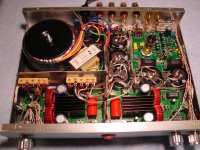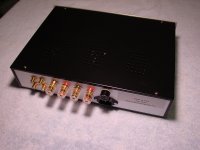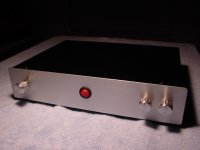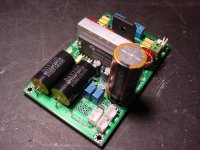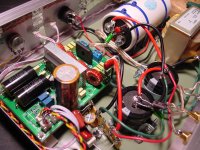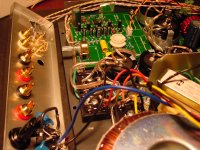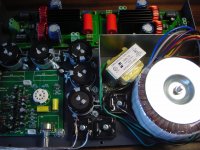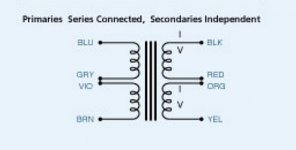mmhh, i forgot about 41hz, i thought that arjen's amp were a little bit better.
i suspect you advice the amp 4 as better equivalent of the arjen ?
i wonder if the 41hz need any tweaks: that said i mean, the arjen and sure have an enormous amount of tweaks, maybe the 41hz doesn't need them.
thanks
Perhaps the Amp11 is most similar to Arjen's amps. The Amp4 is my personal favorite - the sound is amazing, but it's intended for 8 Ohm loads. (Can be tweaked and used with 4 though.)
thanks for the info.
i'm building speakers all the time, most of them are 8 ohms, but my next build might be 4.
how do you modify the amp 4 to 4 ohm ? is it difficult, pricey, and i suppose you end up with 15w ?
thanks
You put in a STA517B output stage chip
Is it normal when mounting the boards to an aluminum enclosure to make a short of the signal and power grounds? I used rubber grommets and machine screws to secure the boards to the enclosure but created a short to the battery PS. Removed the screws and everything is fine :^)
MKII TK2050 has been made
Dear comrades, ( been in china too long )
I have made some sample MKII TK2050 boards, and would like to show the photos.
i'd be happy to receive comments, new features include,
- speaker protection using the two IC's fault lines to disconnect the speakers with a larger relay
- 5V and 24V indicator lights
- even better layout
- 1.5CM shorter board
- same quality stuff like Elna caps and Micro-metal cores
Dear comrades, ( been in china too long )
I have made some sample MKII TK2050 boards, and would like to show the photos.
i'd be happy to receive comments, new features include,
- speaker protection using the two IC's fault lines to disconnect the speakers with a larger relay
- 5V and 24V indicator lights
- even better layout
- 1.5CM shorter board
- same quality stuff like Elna caps and Micro-metal cores
An externally hosted image should be here but it was not working when we last tested it.
I could not wait...
I wanted to do a second 2050 without the tube buffer before Christ-mass, had to go with HifimeDIY. Arjen's 2050 sound fantastic.
...any comments about the comparison between TK2050 boards? first impresions?
Dear comrades, ( been in china too long )
I have made some sample MKII TK2050 boards, and would like to show the photos.
i'd be happy to receive comments, new features include,
- speaker protection using the two IC's fault lines to disconnect the speakers with a larger relay
- 5V and 24V indicator lights
- even better layout
- 1.5CM shorter board
- same quality stuff like Elna caps and Micro-metal coresAn externally hosted image should be here but it was not working when we last tested it.
Arjen, good to see you post again. Your 2050 V2 looks very nice. I like the fact that you used the Elna caps on it.
Only suggestion is that the Audiophiler input caps might be improved by a few dollars with the Dayton 3.3 uF polypropylene--like I did with your TA2020 MKIII (see pictures below). I replaced the input caps and the main filter cap with a Nichicon FW 10,000 uF. A little overkill maybe and it is a matter of taste.
Very nice product and I am sure I will order a set soon after I have some audio friends over to hear your 2050 with the tube buffer and a new set of Cathedrals. Up against it will be an LFD British Amp, and a Music Angel KT88 based tube amp. So far, the TA2020 MKIII held its own pace right behind the LFD on a shoot out (same LFD kind of amp but earlier version as the one reviewed in Jan. Stereophile)
...any comments about the comparison between TK2050 boards? first impresions?
I plan to get started tonight, but really, I do not see how anything can beat my Helder 2050 with the Helder tube buffer. Wish I had waited. We will all see.
Pic of my Helder 2050 with tube buffer. Crowded inside since I did not plan to place all these components inside originally.
Attachments
Nicely Done Whaleman! looks supurb!
for a comparison between the two TK2050's, the sound on the new version is slightly better due to a beefier layout of the tracks, 3mm on both sides on 2 ounce copper thickness, more true holes, and the use of 5X 6uF 50V ceramic caps on the power line just on the other side of the IC to provide the fast fuel for the IC, ive noticed this pushes the performance further, also allowing for less distortion.
in total the total resistance and inductance on the board has been reduced by around 200%, to just a few mOhms in total, i think its the best the TK2050 can do at the moment, and i will also experiment later with some other end stage IC's for some more power.
Greetings and to all you guys, Merry Christmas!
for a comparison between the two TK2050's, the sound on the new version is slightly better due to a beefier layout of the tracks, 3mm on both sides on 2 ounce copper thickness, more true holes, and the use of 5X 6uF 50V ceramic caps on the power line just on the other side of the IC to provide the fast fuel for the IC, ive noticed this pushes the performance further, also allowing for less distortion.
in total the total resistance and inductance on the board has been reduced by around 200%, to just a few mOhms in total, i think its the best the TK2050 can do at the moment, and i will also experiment later with some other end stage IC's for some more power.
Greetings and to all you guys, Merry Christmas!
@to everybody here and Arjen,
I am interested in your opinions. Makes it sense , when
using a noise filter like this modell ?:
Noise Filter MXB Series - TDK-Lambda
I think the more clear the current the better the sound, or not ?
I am interested in your opinions. Makes it sense , when
using a noise filter like this modell ?:
Noise Filter MXB Series - TDK-Lambda
I think the more clear the current the better the sound, or not ?
@to everybody here and Arjen,
I am interested in your opinions. Makes it sense , when
using a noise filter like this modell ?:
Noise Filter MXB Series - TDK-Lambda
I think the more clear the current the better the sound, or not ?
Whether there is a problem or not, or to what extent, is highly variable and is really specific to your individual location, power company, etc. To a certain extent the quality of your AC power is dependant on your neighbours, who share the utility supply with you.
There are no real standard configurations of utility delivery systems and layout; it's hardly unheard of for one area of a city to have different configurations than another, for example, even if both are non-industrial portions of the local grid. Also, broadly speaking, these kinds of issues tend to get worse over time, as more is asked of the existing utility, and noisier appliances are added to the AC lines, each day in our modern world.
So, to what extent utility noise is a problem is really something that can't really be determined in a forum like this with a worldwide audience. Good, clean, well regulated utilities apparently do exist.
There are those that report that these types of line filters, when used in the audio equipment themselves, can cause restrictions in dynamics.
However, that may be limited to high current demand applications only, which the typical T-amp is not. You could try it and see, of course.
Regardless, the usual recommended application in audio is to apply the filters at household appliances that can introduce noise into the home AC wiring ... these filters work both ways.
Typical recommendations would be things like other items that tend to introduce noise into the home AC line on the homeowner's side of the breaker panel. For example, items with motor-start cycles, like refrigerators or Air Conditioning units. Similarly, things like flat-panel TVs with switching supplies, that are normally always on.
It's possible for the homeowner to have systems in place that are very noisy; for example the X-10 type home automation products. Again, you or your near neighbours could be using such devices.
Were it me, I would use the ones rated at 20A on a 15A 120V line (for example). There is not much difference in price between the various amperage rated units (they are typically about $75).
Last edited:
Hi Johnny, thanks much for the clearance and your advices. The mentioned modell in the beginning of my post I could get for a special price because it's used. It costs me less than 15 $. I have bought two pieces to test. I expect not a huge increase. But as you notified: for the case of case. I am living closed to a train station. I also heard that this issue could be responsible for "dirty" current from time to time.Were it me, I would use the ones rated at 20A on a 15A 120V line (for example). There is not much difference in price between the various amperage rated units (they are typically about $75).
i'd be happy to receive comments, new features include,
- speaker protection using the two IC's fault lines to disconnect the speakers with a larger relay
- 5V and 24V indicator lights
- even better layout
- 1.5CM shorter board
- same quality stuff like Elna caps and Micro-metal cores
Arjen,
These improvements are great, the led indicators is great idea, and the lower resistance due to better layout will make the sound even better.
I would have one question and one comment...
1. On the current version MKI, where is the best place and best way to add such a 24V indicator LED ?
2. About the layout, maybe if the speaker outputs were on the same side as signal input, it would make them easier to install and it would allow to have the shortest wirings to the terminals on the backside of the cabinet. And the shortest, the better. I know, I talk about just 2 or 3 cm.
Regards
Pic of my Helder 2050 with tube buffer. Crowded inside since I did not plan to place all these components inside originally.
Very nice work Whaleman !
I know there is some posts in another thread (Hifimediy) about you linear PSU.
I will go the same way as you for my 2 mono Arjen boards and I am confused on one pont... maybe you can help.
When linking the two rectifier bridges to a common ground, like the shematic from TNT audio, we obtain -24V 0V +24V.


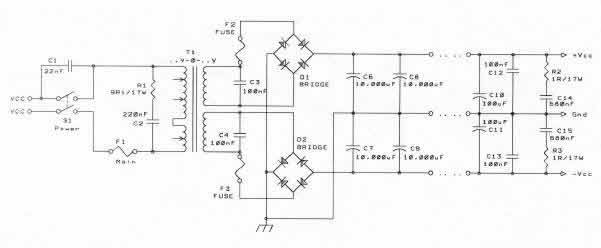
Have you done this and connected one board to -24V / 0 and the other one to 0 / +24V ?
I suppose that, with two separate floating grounds, i could obtain 0V/+24V from each rail. Is it right ? What is the best schematic ?
Very nice work Whaleman !
I know there is some posts in another thread (Hifimediy) about you linear PSU.
I will go the same way as you for my 2 mono Arjen boards and I am confused on one pont... maybe you can help.
When linking the two rectifier bridges to a common ground, like the shematic from TNT audio, we obtain -24V 0V +24V.


Have you done this and connected one board to -24V / 0 and the other one to 0 / +24V ?
I suppose that, with two separate floating grounds, i could obtain 0V/+24V from each rail. Is it right ? What is the best schematic ?
That schematic is for a configuration requiring negative voltage. The Helder monoblocks only require positive voltage. If you use one bridge, then you will have just one ground and one positive post to feed both amp monoblocks.
If you use 2 bridges, then do not connect the bridge grounds together, keep them both totally separate, and hopefully you have 2 sets of secondaries on your transformer, or 2 transformers to feed each bridge individually. See attached Avel transformer schematic.
The toroidal I used had 2 secondary sections, so I used one each for each Helder monoblock. So, from one secondary I went to the rectifier bridge, and then to two 12,000 uF filtering capacitors in seriess. If you can imagine just using the upper half of the schematic and not connecting the bridge grounds together for both monoblocks, it might help.
In this picture, you can see the Avel toroidal. One secondary section is the red and black wire, mounted on one bridge, the other is the orange and yellow wire mounted on the other bridge. The third bridge is separate for feeding the tube buffer only with its own separate transformer.
Hope this makes sense.
Attachments
Last edited:
- Status
- This old topic is closed. If you want to reopen this topic, contact a moderator using the "Report Post" button.
- Home
- Amplifiers
- Class D
- Arjen Helder's 2050 boards
